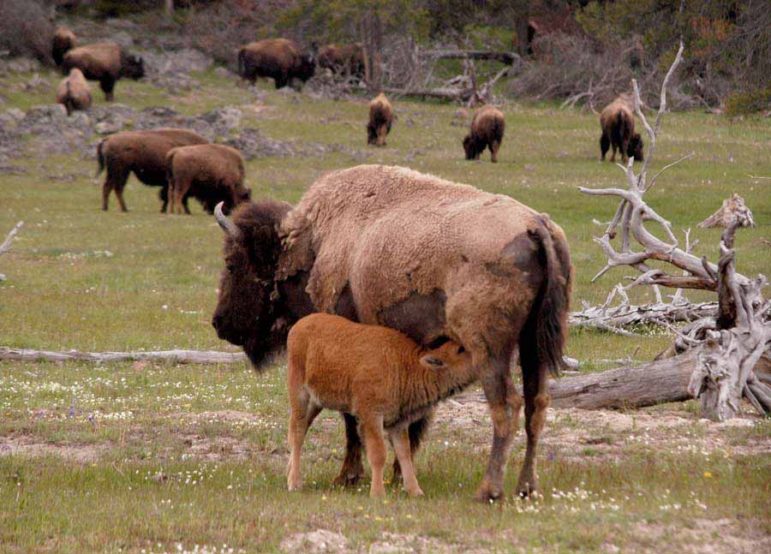
A proposal to dramatically expand the territory available for bison living in and around Yellowstone National Park s still under consideration, despite a decision by the Montana Board of Livestock this week to table the plan pending further analysis.
The plan to boost available habitat from about 40,000 acres used mostly on a seasonal basis to 420,000 acres year-round west and north of Yellowstone in Hebgen Lake Basin, the Taylor Fork of the Gallatin River and other areas “remains viable,” according to Pat Flowers, southwest regional supervisor of Montana Fish, Wildlife and Parks.
State officials will now rework the proposal to address concerns and suggestions raised at Tuesday’s meeting where the Board of Livestock voted to take no action. Board members sought more involvement from the cattle industry and details about how much it would cost to manage an area about 10 times the size of current habitat.
The board pressed proponents of the plan, jointly advanced by Montana Fish, Wildlife and Parks and the Department of Livestock, to spell out funding sources for various activities, to designate which state office would have authority over enforcement, and to estimate costs to livestock producers in the affected area.
Flowers and Department of Livestock Executive Director Christian MacKay agreed to do more work on the plan and include more details before bringing it to the board’s next meeting, scheduled May 19-20 in Helena, for further consideration.
MacKay felt it was “important to note” that the board simply tabled the matter rather than voting it down, according to the Bozeman Daily Chronicle, while Flowers suggested to the Associated Press that the new plan may actually cost less than current policies which require a helicopter to haze bison back into the park after they leave in the winter.
The proposal to allow bison to occupy more than 400,000 acres of federal, state and private land northwest of Yellowstone on a year-round basis was first presented to the board in January, when the board voted against it.
The revised plan added a condition that would only make the expanded zone available whenever Yellowstone’s bison population is less than 3,300, as determined by a count conducted after hunting and other population reduction measures were over for the winter and prior to the spring calving season. By contrast, at the end of last summer park biologists estimated the park’s population at 4,600.
The latest proposal would allow bison to roam the larger “bison-tolerance zone” all year long in both the Gardiner Basin, where they currently have seasonal access, and an area outside of West Yellowstone. However, if the population exceeded 3,300, both areas would become more restricted, and if it went over 4,000, no new areas would be open.
The controversial plan drew media coverage this week across the nation from the San Francisco Chronicle to The Kansas City Star and The Wall Street Journal, and attracted varied opinions from hunters, ranchers, and environmentalists.
Even though wildlife enthusiasts have promoted greater migration opportunities for bison for many years, the population-trigger of 3,300 drew criticism from the Gallatin Wildlife Association and Defenders of Wildlife. Some members of the livestock board favored a slightly lower trigger of 3,000, a level the park hasn’t witnessed since 2009 after more than 1,600 were captured and shipped to slaughter or killed by hunters during the previous winter.
“The proposal is the opposite of what should be happening,” Defenders of Wildlife spokesman Jonathan Proctor told the Chronicle. “When the numbers in the park are larger, that’s when bison should be allowed outside the park to help with management through the use of tribal and regular hunts.”
As the result of legal actions in recent years, state and federal agencies have attempted to keep Yellowstone’s bison population at 3,000 through various strategies ranging from killing bison that roam too far out of Yellowstone to issuing limited numbers of bison-hunting licenses and shipping bison to slaughter.
Montana’s Fish, Wildlife and Parks only grants about 50 hunting licenses each year, but receives about 10,000 applications. Proponents of the year-round extended range say it would allow fairer hunting opportunities. And some Montana hunters who believe in hunting as a conservation measure are enthusiastic about the prospect.
As one hunter, Chris Marchion of Anaconda, told The Wall Street Journal, “They’re a tremendously large, strong animal and a challenge as a hunter to make a good clean kill. When you do, you really have a tremendous amount of great quality meat.”
Glenn Hockett, president of the Gallatin Wildlife Association, a conservation group that promotes more bison hunting opportunities, encouraged state officials to focus on how many bison could live in Montana rather than how many should be in Yellowstone.
“It’s irrelevant if there’s 10,000 bison in the park in my mind,” he told AP. “It should be what is your tolerance for bison in Montana.”
While livestock interests have worried that allowing a broader range for bison could spread brucellosis and increase the competition between bison and cattle, proponents of the expansion maintain it would actually lessen those problems because spreading the bison out in a larger area would reduce bison-cattle encounters.
